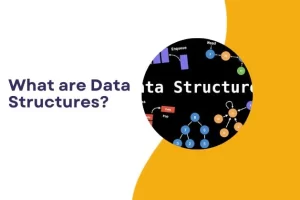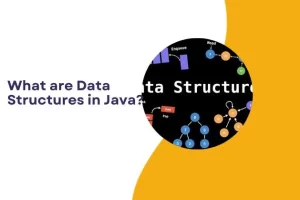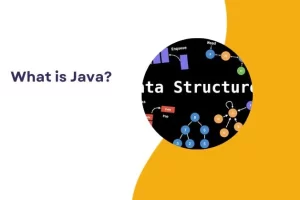Table of Contents
ToggleIntroduction
Data structures in java are fundamental components of algorithm design that play a crucial role in enhancing the performance of software applications.
These structures serve as the backbone of efficient algorithm design, providing developers with a powerful set of tools to handle and manipulate data in diverse ways.
In the world of Java programming, there exists a rich collection of built-in data structures that empowers developers to optimize their code and achieve better results.
In this blog, we will explore some essential data structures in Java, providing insights into their application, benefits, and implementation intricacies.
By diving into these fundamental concepts, readers will gain a deeper understanding of how data structures can enhance the functionality and efficiency of their Java programs.
What is Java?
Java Programming is a versatile and robust high-level programming language that was originally developed by Sun Microsystems.
With its strong emphasis on reliability, object-orientation, and security, Java has become one of the most widely used languages in the world of software development.
One of the key features that sets Java apart from other programming languages is its adherence to the WORA principle, which stands for “Write Once Run Anywhere”.
This means that once a Java program has been written and compiled, it can be executed on any platform that supports Java without the need for additional modifications or adaptations.
This not only saves time and effort for developers but also allows for greater flexibility and accessibility in terms of where the program can be run.
Furthermore, due to its object-oriented nature, Java allows for the creation of modular and reusable code, making it an efficient choice for building complex and scalable applications.
Have a look at the following: data science course in delhi
What are Data Structures?

Data structures in java are fundamental constructs in computer science that enable the efficient organization, storage, and retrieval of data.
Think of them as specialized formats for organizing and storing information in a way that facilitates various operations.
These structures act as the building blocks for algorithms, providing a blueprint for how data is managed within a program.
The choice of a particular data structure depends on the nature of the data and the operations that need to be performed.
From simple arrays to more complex structures like linked lists, stacks, queues, trees, and hash tables, each data structure serves a specific purpose and comes with its own set of advantages and trade-offs.
In essence, data structures are the backbone of effective algorithm design, influencing the performance and efficiency of software applications.
What are Data Structures in Java?

In the context of Java programming, data structures refer to specialized formats and containers that allow for the efficient organization, storage, and manipulation of data.
Java provides a robust set of built-in data structures that serve as tools for developers to manage information effectively.
These structures, including arrays, linked lists, stacks, queues, trees, and hash tables, empower programmers to tailor their data handling approach based on the specific requirements of their applications.
Leveraging these data structures is integral to writing optimized and scalable Java code, enabling developers to implement algorithms that operate swiftly and with minimal resource consumption.
Essentially, data structures in Java are the essential components that facilitate the seamless handling of data, contributing to the overall efficiency and performance of Java applications.
Types of Data Structures in Java

In Java, a diverse array of built-in data structures empowers developers to handle data in various ways.
Here are some key types of data structures commonly used in Java:
Arrays:
Arrays are the simplest form of data structures, providing a fixed-size sequential collection of elements of the same type.
They offer fast and direct access to elements but have a fixed size.
java
int[] myArray = new int[]{1, 2, 3, 4, 5};
Linked Lists:
Linked lists allow dynamic memory allocation, overcoming the fixed size limitation of arrays.
Elements, called nodes, are linked together, and each node contains data and a reference to the next node.
java
LinkedList<String> linkedList = new LinkedList<>();
linkedList.add(“Java”);
linkedList.add(“Data Structures”);
Stacks:
Stacks follow the Last In, First Out (LIFO) principle.
Java’s Stack class extends Vector and provides methods for stack operations like push and pop.
java
Stack<Integer> stack = new Stack<>();
stack.push(1);
stack.push(2);
int poppedElement = stack.pop(); // Returns 2
Queues:
Queues adhere to the First In, First Out (FIFO) principle.
The Queue interface in Java, often implemented using LinkedList, supports operations like add and remove.
java
code
Queue<String> queue = new LinkedList<>();
queue.add(“First”);
queue.add(“Second”);
String removedElement = queue.remove(); // Returns “First”
Trees:
Trees are hierarchical structures with a root element and child elements.
Java’s TreeSet and TreeMap classes implement tree structures, providing efficient searching and sorting.
java
TreeSet<Integer> treeSet = new TreeSet<>();
treeSet.add(5);
treeSet.add(2);
Hash Tables:
Hash tables, or HashMaps in Java, store data in key-value pairs.
They offer constant-time complexity for basic operations, making them efficient for tasks like retrieval and insertion.
java
HashMap<String, Integer> hashMap = new HashMap<>();
hashMap.put(“One”, 1);
int value = hashMap.get(“One”); // Returns 1
These data structures in Java cater to different needs, and choosing the right one depends on the specific requirements and characteristics of the data and operations involved.
Advantages of Data Structures in java
The use of data structures in Java brings about several advantages, enhancing the efficiency, performance, and organization of software applications. Here are some key advantages:
Efficient Data Retrieval and Storage:
Data structures in java enable organized and efficient storage of data, allowing for quick retrieval and manipulation.
For example, arrays provide constant-time access to elements, while hash tables offer fast key-based retrieval.
Optimized Performance:
Choosing the right data structures in java for a specific task can significantly boost the performance of algorithms.
Well-designed data structures facilitate faster execution of operations, contributing to overall program efficiency.
Dynamic Memory Allocation:
Some d
ata structures, like linked lists, allow for dynamic memory allocation, overcoming the fixed-size limitation of arrays.
This dynamic nature facilitates efficient memory utilization and management.
Ease of Implementation:
Java provides a rich set of built-in data structures, making it easier for developers to implement complex algorithms without having to build these structures from scratch.
This abstraction simplifies the coding process and reduces the likelihood of errors.
Versatility and Flexibility:
Different data structures cater to different types of data and operations.
This versatility allows developers to choose the most suitable structure for their specific needs, adapting to the characteristics of the data and the requirements of the application.
Support for Specialized Operations:
Certain data structures are optimized for specific operations. For instance, stacks and queues are designed for efficient last-in-first-out (LIFO) and first-in-first-out (FIFO) operations, respectively.
Search and Retrieval Efficiency:
Data structures like trees and hash tables offer efficient searching and retrieval mechanisms.
Trees, in particular, provide logarithmic time complexity for searching and sorting operations, making them suitable for a variety of applications.
Conservation of Resources:
Well-designed data structures help conserve resources such as memory and processing power.
Efficient data management reduces the overall resource footprint of the application, contributing to better scalability and responsiveness.
Facilitation of Algorithm Design:
Data structures serve as the foundation for algorithm design.
They provide a framework that helps developers conceptualize and implement algorithms in a systematic and optimized
manner.
Ease of Maintenance:
Using established data structures promotes code clarity and maintainability.
It becomes easier for developers to understand and maintain code that utilizes common and well-documented data structures.
In summary, the judicious use of data structures in Java leads to improved program efficiency, resource utilization, and overall code quality.
These advantages play a crucial role in the development of robust and high-performance software applications.
Classification of Data Structures in java
Data structures in java can be classified based on their organization, behavior, and usage patterns, providing a systematic way to understand and categorize these fundamental building blocks in computer science.
Based on Organization:
Linear Data Structures: Elements are arranged sequentially, with each element having a unique predecessor and successor. Examples include arrays, linked lists, stacks, and queues.
Non-linear Data Structures: Elements are not arranged in a sequential manner. Trees and graphs are common examples, offering hierarchical and interconnected relationships between elements.
Based on Behavior:
Static Data Structures: The size and structure are fixed at compile time. Arrays are a classic example, where the size must be specified in advance.
Dynamic Data Structures: The size and structure can change during runtime. Linked lists are dynamic, allowing for the addition or removal of elements without a predefined size.
Based on Accessibility and Update:
Primitive Data Structures: Basic data types like integers, floats, and characters that directly operate upon machine instructions.
Composite Data Structures: Collections of primitive data types, such as arrays and structures, allowing for the creation of more complex data structures.
Linear Data Structures:
Arrays: Suitable for situations where fixed-size, contiguous memory allocation is beneficial.
Linked Lists: Ideal for scenarios requiring dynamic memory allocation and frequent insertions and deletions.
Stacks and Queues: Valuable for managing data in a last-in-first-out (LIFO) or first-in-first-out (FIFO) manner, respectively.
Non-linear Data Structures:
Trees: Efficient for hierarchical relationships and searching operations.
Conclusion
Having a thorough understanding of data structures in java is essential for crafting well-performing and adaptable Java programs.
Data structures are integral components that determine the efficiency and scalability of a program, and each one possesses unique strengths and limitations.
When it comes to selecting the most suitable data structure for a particular application, it is crucial to consider the specific requirements and needs of the project.
One significant advantage of utilizing the built-in data structures in Java is their ability to enhance the robustness and performance of software solutions.
By leveraging these pre-existing data structures, developers can efficiently manage and organize complex sets of data, ultimately resulting in more efficient and streamlined code.
Java offers a versatile toolkit that includes various data structures such as arrays, linked lists, stacks, queues, trees, and hash tables.
Each type serves a different purpose in managing different types of data. For instance, arrays are useful for storing fixed-size collections of elements while linked lists are ideal for handling dynamic sets of data.
Frequently Asked Questions (FAQs)
What is the significance of data structures in Java?
Data structures in Java are essential for efficient organization, storage, and retrieval of data. They serve as the building blocks for algorithm design, impacting the performance and scalability of software applications.
What are the common built-in data structures in Java?
Java provides a variety of built-in data structures, including arrays, linked lists, stacks, queues, trees, and hash tables (HashMap).
How do arrays differ from linked lists in Java?
Arrays have a fixed size and offer constant-time access, while linked lists allow dynamic resizing and efficient insertions and deletions at any position.
When would you use a stack in Java?
Stacks are useful when you need to implement a Last In, First Out (LIFO) data structure, such as in parsing expressions, backtracking algorithms, or managing function calls in recursion.
What is the advantage of using hash tables (HashMap) in Java?
Hash tables provide constant-time complexity for basic operations like insertion, retrieval, and deletion, making them efficient for tasks involving key-value pairs.
How are trees used in Java programming?
Trees are hierarchical data structures with a root node and branches. In Java, they are commonly used for efficient searching, sorting, and representing hierarchical relationships in data.
Can you provide an example of when to use a queue in Java?
Queues, with their First In, First Out (FIFO) behavior, are beneficial in scenarios such as task scheduling, printing jobs, or managing resources in a way that prioritizes the order of arrival.
What is the role of data structures in algorithm design?
Data structures serve as the foundation for algorithm design. The choice of an appropriate data structure influences the efficiency and complexity of algorithms.
Are there any limitations to using arrays in Java?
Yes, arrays in Java have a fixed size, and once declared, their size cannot be changed. This limitation makes them less flexible for dynamic data storage.
How do data structures contribute to code optimization in Java?
Choosing the right data structure can optimize the performance of algorithms, reduce resource consumption, and enhance the overall efficiency of Java code.














